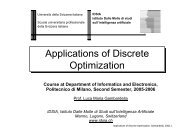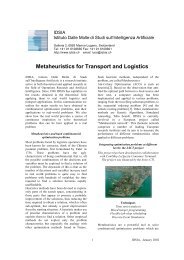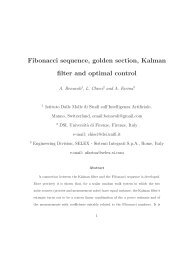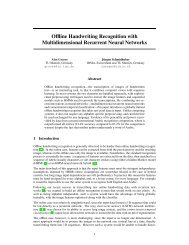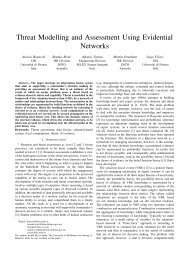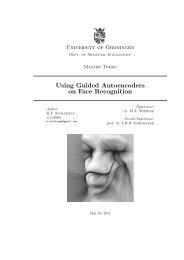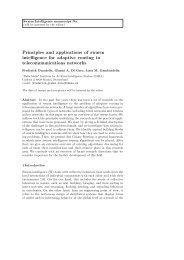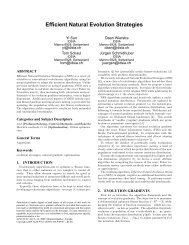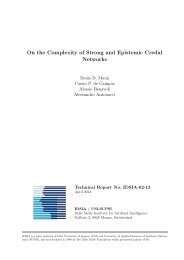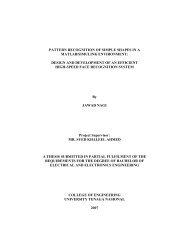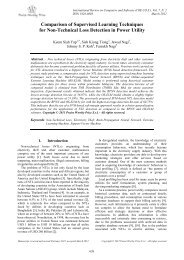AntHocNet: an Ant-Based Hybrid Routing Algorithm for ... - CiteSeerX
AntHocNet: an Ant-Based Hybrid Routing Algorithm for ... - CiteSeerX
AntHocNet: an Ant-Based Hybrid Routing Algorithm for ... - CiteSeerX
Create successful ePaper yourself
Turn your PDF publications into a flip-book with our unique Google optimized e-Paper software.
For the longer areas, the difference in delivery ratio becomes bigger, <strong>an</strong>d AODV<br />
also looses its adv<strong>an</strong>tage in delay. If we take a look at the 99 th percentile of the<br />
delay, we c<strong>an</strong> see that the decrease in per<strong>for</strong>m<strong>an</strong>ce of AODV is mainly due to a<br />
small number of packets with very high delay. This me<strong>an</strong>s that AODV delivers<br />
packets with a very high delay jitter, a crucial problem in terms of quality of<br />
service (QoS). The jitter could be reduced by removing these packets with very<br />
high delay, but that would me<strong>an</strong> <strong>an</strong> even worse delivery ratio <strong>for</strong> AODV. Next<br />
0.98<br />
0.96<br />
0.94<br />
<strong><strong>Ant</strong>HocNet</strong><br />
AODV<br />
1.2<br />
1<br />
0.8<br />
<strong><strong>Ant</strong>HocNet</strong><br />
<strong><strong>Ant</strong>HocNet</strong> 99%<br />
AODV<br />
AODV 99%<br />
0.92<br />
0.9<br />
0.6<br />
0.88<br />
0.4<br />
0.86<br />
0.2<br />
0.84<br />
1600 1800 2000 2200 2400<br />
0<br />
1600 1800 2000 2200 2400<br />
Fig. 1. On the left the delivery ratio (the fraction of sent packets which actually arrives<br />
at their destination) <strong>an</strong>d on the right the average <strong>an</strong>d the 99 th percentile of the delay<br />
per packet. On x-axis the long edge of the area: starting from the base scenario of<br />
1500 × 300 m 2 , <strong>an</strong>d ending at 2500 × 300 m 2 .<br />
we ch<strong>an</strong>ged the mobility of the nodes, varying the pause time between 0 seconds<br />
(all nodes move const<strong>an</strong>tly) <strong>an</strong>d 900 seconds (all nodes are static). The area<br />
dimensions were kept on 2500 × 300 m 2 , like at the end of the previous experiment<br />
(results <strong>for</strong> 1500 × 300 m 2 were similar but less pronounced). In figure<br />
2 we c<strong>an</strong> see a similar trend as in the previous experiment. For easy situations<br />
(long pause times, hardly <strong>an</strong>y mobility), <strong><strong>Ant</strong>HocNet</strong> has a higher delivery ratio,<br />
while AODV has lower delay. As the environment becomes more difficult (high<br />
mobility), the difference in delivery ratio becomes bigger, while the average delay<br />
of <strong><strong>Ant</strong>HocNet</strong> becomes better th<strong>an</strong> that of AODV. Again, the 99 th percentile of<br />
AODV shows that this algorithm delivers some packets with a very high delay.<br />
Also <strong><strong>Ant</strong>HocNet</strong> has some packets with a high delay (since the average is above<br />
the 99 th percentile), but this number is less th<strong>an</strong> 1% of the packets. In a last<br />
experiment we increased the scale of the problem. Starting from 50 nodes in a<br />
1500 × 500 m 2 area, we multiply both terrain edges by a scaling factor <strong>an</strong>d the<br />
number of nodes by the square of this factor, up to 200 nodes in a 3000×1000 m 2<br />
area. The results, presented in figure 3, show again the same trend: as the problem<br />
gets more difficult, the adv<strong>an</strong>tage of <strong><strong>Ant</strong>HocNet</strong> in terms of delivery ratio<br />
increases, while the adv<strong>an</strong>tage of AODV in terms of average delay becomes a<br />
disadv<strong>an</strong>tage. Again this is due to a number of packets with a very high delay.<br />
The experiments described above show that <strong><strong>Ant</strong>HocNet</strong> has some clear adv<strong>an</strong>tages<br />
over AODV. First of all, <strong><strong>Ant</strong>HocNet</strong> gave a better delivery ratio th<strong>an</strong><br />
AODV in all scenarios. The construction of multiple paths at route setup, <strong>an</strong>d<br />
8



